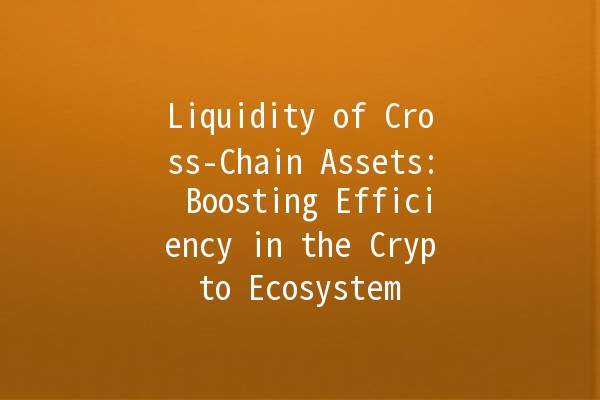
As blockchain technology evolves, the need for liquidity in crosschain assets becomes increasingly critical. Liquidity refers to the ease with which assets can be bought or sold in the market without affecting their price. Understanding and improving liquidity in crosschain assets can significantly enhance the efficiency of the cryptocurrency ecosystem. This article examines practical techniques to enhance liquidity, focusing on various strategies to optimize the movement of assets across different blockchain networks.
Understanding CrossChain Liquidity
Crosschain liquidity is essential for maximizing the utility of digital assets. When users can easily exchange assets between different blockchain platforms, it increases market efficiency and expands the utility of assets. Crosschain solutions facilitate this by enabling decentralized finance (DeFi) protocols to interact seamlessly across multiple chains.
The liquidity of crosschain assets is influenced by several factors, including the number of users on each platform, transaction speeds, and the integration of liquidity protocols. By enhancing these aspects, we can improve the overall user experience, encouraging more participants to engage with crosschain liquidity solutions.
Techniques to Enhance CrossChain Liquidity

Explanation: DEXs are platforms that allow users to trade cryptocurrencies directly with one another without the need for an intermediary. They utilize smart contracts to facilitate transactions.
Application Example: Users can utilize DEXs like Uniswap or PancakeSwap to swap tokens across different blockchains. By providing liquidity to these platforms, users can earn fees while simultaneously enhancing liquidity for crosschain assets. This can include participating in liquidity pools that support wrapped versions of tokens, which represent assets from other chains on a given blockchain.
Explanation: An atomic swap is a smart contract technology that allows exchange transactions to occur between different cryptocurrencies without the need for a trusted third party.
Application Example: Suppose a user wants to trade Bitcoin for Ethereum. Through atomic swaps, the user can execute a transaction directly across the Bitcoin and Ethereum networks without intermediaries, thus enhancing liquidity by allowing more flexible trading options.
Explanation: Crosschain bridges are protocols designed to allow users to transmit assets between different blockchain networks securely. These bridges often lock assets on one chain while minting equivalent tokens on another.
Application Example: With the EthereumtoPolygon bridge, users can transfer their Ethereum assets to Polygon, where transaction costs are lower, yet still participate in DeFi applications. This not only enhances liquidity on Polygon but also provides Ethereum holders with more opportunities for yield generation across chains.
Explanation: Liquidity mining incentivizes users to provide liquidity to specific platforms by offering them rewards, often in the form of additional tokens.
Application Example: Users might provide liquidity to a specific DEX or crosschain protocol, receiving tokens as a reward. By doing so, they amplify liquidity for crosschain assets while benefiting from potential returns on their investments. Additionally, projects like SushiSwap and Yearn ance offer liquidity mining programs that can support crosschain asset utilization.
Explanation: Interoperable protocols allow different blockchains to communicate and function together, thereby increasing the liquidity pools available to various assets.
Application Example: Projects such as Polkadot and Cosmos create ecosystems where assets can be transferred seamlessly between multiple blockchains. By building on these platforms, developers can create applications that enhance the fungibility of crosschain assets, significantly increasing liquidity.
Frequently Asked Questions
Crosschain liquidity provides numerous advantages, including enhanced market efficiency, lower volatility, and improved trading opportunities. By allowing assets to be easily exchanged across chains, it opens up new avenues for users to participate in various DeFi projects, thus expanding the overall market landscape.
Crosschain bridges function by locking an asset on one blockchain and minting an equivalent asset on another blockchain. For example, when a user moves Bitcoin to Ethereum via a bridge, the Bitcoin is locked, and an equivalent amount of "wrapped" Bitcoin is created on Ethereum. This process enables seamless asset transfers between two distinct ecosystems.
Although crosschain solutions offer many benefits, they do carry risks, such as smart contract vulnerabilities and reliance on thirdparty platforms. Users should conduct thorough research on the protocols they use and be mindful of potential risks, including liquidity issues and the possibility of unsuccessful transactions.
To identify the best DEXs for crosschain trading, users should consider factors like transaction fees, user interface, trading volume, and available liquidity pools. Community feedback and reviews often provide insight into the effectiveness and reliability of various platforms.
Yes, several tokens are particularly recognized for their crosschain capabilities, such as Wrapped Bitcoin (WBTC) and RenBTC. These tokens have been explicitly designed to enhance liquidity across different blockchain platforms, making it easier for users to access liquidity without being tied to a single blockchain.
Liquidity mining can significantly impact crosschain liquidity by incentivizing users to provide liquidity for specific tokens and protocols. When users earn rewards for contributing to liquidity pools, they are more likely to participate actively, ultimately increasing liquidity for crosschain assets and enhancing market stability.
Additional s on CrossChain Asset Liquidity
Crosschain asset liquidity is more than just a technical concept; it embodies the evolution of the cryptocurrency ecosystem. As more projects focus on interoperability and the ability to transfer assets seamlessly, we can expect a surge in user adoption and trading activity. Enhanced liquidity will foster market resilience, reduce arbitrage opportunities, and create a more cohesive financial ecosystem across various blockchain platforms.
Furthermore, ongoing advancements in technology, such as Layer 2 solutions and improved consensus mechanisms, will continue to drive liquidity in crosschain assets. As users gain greater access and better tools for managing crosschain assets, market dynamics will evolve, ultimately shaping the future landscape of decentralized finance.
This comprehensive breakdown covers key techniques and answers common inquiries surrounding the liquidity of crosschain assets. These insights will help readers navigate the burgeoning field of crosschain liquidity while providing practical strategies for maximizing their engagement with digital assets in this exciting new era.

